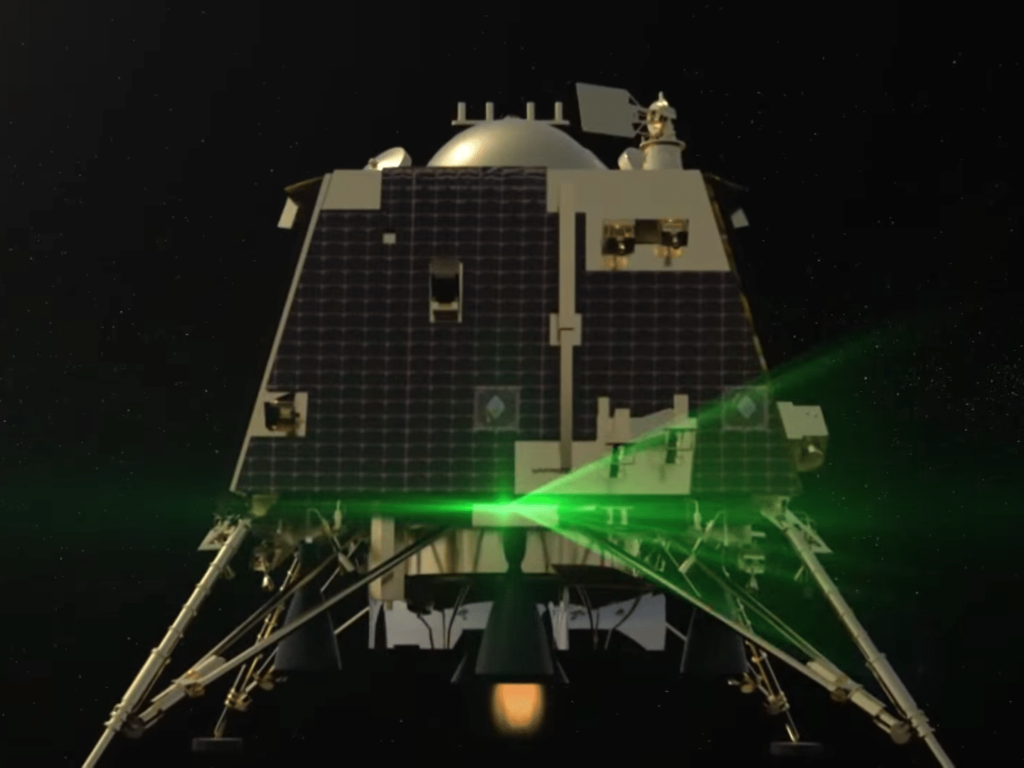The Chandrayaan 3 mission consisted of three elements, a Propulsion Module, the Vikram Lander and the Pragyan Rover. The initial plan for the mission was that ISRO would use the Propulsion Module to ferry the Lunar Module, consisting of the Vikram Lander and the Pragyan Rover to lunar orbit, where the Lunar Module would separate from the Propulsion Module. The Propulsion Module would then separate from the Lunar Module, and continue to orbit the Moon, studying the Earth from lunar orbit, with the Spectro-polarimetry of HAbitable Planet Earth (SHAPE) payload.
The Vikram Lander would execute a soft, controlled landing on the lunar surface, with the Pragyan Rover rolling out of the belly of the lander, to explore the surface of the Moon. ISRO achieved every step in the mission, as well as all the mission objectives. The planned duration of the mission was for a single lunar day.
The sensitive electronic instruments on board the spacecraft did not survive the harsh lunar nights where temperatures can drop to -180°C. On the journey to the Moon, ISRO made sure to communicate every single crucial engine burn, through a series of orbit raising manoeuvres during the Earthbound phase of the mission, and then a series of manoeuvres to reduce the altitude in lunar orbit, till the spacecraft reached the parking orbit at an altitude of 100 kilometres. ISRO has also publicly disseminated scientific observations by the payloads on the lunar surface… except one, the SHAPE instrument.
ISRO has secretly returned the Chandrayaan 3 Propulsion Module back to Earth Turns out that the ISRO scientists had stretch goals when it came to the Chandrayaan 3 mission. Although ISRO has transparently communicated most of the operations over the course of the mission, there were a series of operations that were surprise announcements. The latest of these is that ISRO has secretly returned the Chandrayaan 3 Propulsion Module back to Earth orbit .
As the mission was nominal, and all the manoeuvres perfect, the Propulsion Module was left in lunar orbit with an excess of fuel, about 150 kg of it. ISRO’s original plan was to continue observations of the Earth from lunar orbit, but after evaluating the options, ISRO engineers came up with a surprise plan that was executed in secrecy. A series of orbital raising manoevures, as well as lunar flybys were then conducted over a period of three months, to return the Propulsion Module to Earth orbit.
With the operation, ISRO has prevented the Propulsion Module ending up as junk on the lunar surface after it ran out of fuel. ISRO has demonstrated that it is a responsible spacefaring nation by returning the Propulsion Module. Additionally, it has demonstrated the capabilities necessary for a future Sample Return mission .
The Chandrayaan 4 mission is currently being developed as a sample return exercise . This was however, not the first surprise from ISRO over the course of the mission. The Propulsion Module had a radioisotope heater unit on board ISRO had not officially and publicly disclosed the presence of a radioisotope heater unit (RHU) on board the Propulsion Module.
The low-power RHU was included as a last-minute addition to the mission to evaluate its performance during the course of the Chandrayaan 3 mission. There was no space available to integrate the RHU into the lander or rover, during advance stages of the mission planning where the RHU became available. Such a radiation source can allow future missions to the lunar surface to operate for longer than a lunar day , surviving the harsh lunar nights.
The Russian Luna 25 mission, which crashed into the lunar surface ahead of a planned landing attempt on August 22, 2023, had a radioisotope thermoelectric generator (RTG) on board, that could provide the spacecraft with some amount of power to keep the systems running in the absence of sunlight for the solar panels to derive energy, during the 14 Earth day long lunar nights. Most of the energy though, would have been used to keep the sensitive electronics on board warm through the lunar nights. The RTG is a more advanced technology than the RHU.
ISRO is planning to develop higher power RHUs for future space missions. Chandrayaan 3 executed two soft landings on the Moon When Chandrayaan 3 successfully landed on the lunar surface on August 23, 2023 , it demonstrated that ISRO has the capabilities of delivering payload at a time and location of its choice to the lunar surface. Towards the end of the lunar day, on November 04, 2023, ISRO executed a surprise hop on the lunar surface , moving the Vikram Lander sideways by around 40 centimetres.
This manoeuvre allowed ISRO scientists to get the first hand experience of firing engines and lifting off from an extraterrestrial surface. It also had the benefit of allowing the scientific instruments on board to capture measurements at two unique locations on the lunar surface, allowing scientists to compare the two sets of readings. Also Read | LUPEX mission by ISRO and JAXA will guide future international activities on surface of Moon The sideways hop on the lunar surface, as well as the Propulsion Module returning to Earth are both exercises that allows ISRO to prepare for future sample return missions, as well as human missions to the surface of the Moon.
These missions will require an Ascender or a human rated lunar lander to lift off from the surface of the Moon, dock with a spacecraft orbiting in lunar orbit, and then make the journey back home. Future lunar missions can also be expected to operate for longer than a lunar day, by benefiting from a radioactive heat source. Also Read | ISRO is headed to Moon for scientific, geopolitical, economic objectives: S Somanath.
From: news9live
URL: https://www.news9live.com/science/all-the-surprising-ninja-operations-by-isro-over-course-of-chandrayaan-3-mission-2368867
